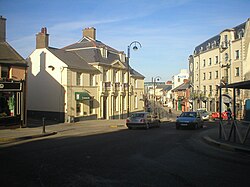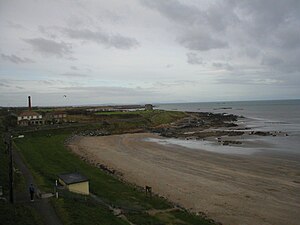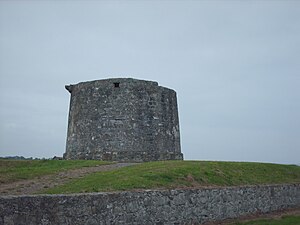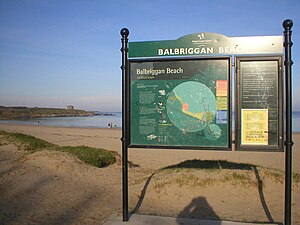Balbriggan
| Balbriggan Gaelic: Baile Brigín | |
| County Dublin | |
|---|---|
 Bridge Street, Balbriggan | |
| Location | |
| Grid reference: | O200641 |
| Location: | 53°36’36"N, 6°11’2"W |
| Data | |
| Population: | 15,559 (2006) |
| Post town: | Balbriggan |
| Postcode: | K32 |
| Local Government | |
| Council: | Fingal |
| Dáil constituency: |
Dublin North |
| Website: | http://www.balbriggan.ie |
Balbriggan is a town in the northern part of County Dublin. The 2011 census population was 19,960 for Balbriggan and its environs.[1]
Origins of the name
According to P.W. Joyce the name arises from "Baile Breacain" [sic] which literally means "Brecan's Town".[2] Brecan is a common medieval first name and there are several other Brackenstowns in Ireland. There is also a possible link to the local Bracken River, in which case the name could derive from breicín "little trout".
Many locals however have traditionally felt that Baile Brigín means "Town of the Little Hills", due to the relatively low hills that surround the town. This translation is not well founded as it appears to be derived from a phonetic deconstruction of a suggested spelling.[3]
It seems more likely that the town's name is derived from the word Brecan, as the area was known in pre-Norse invasion times as Breaga, populated by a tribe or clan known as the Bregii[4] and the aforementioned River Bracken.
History
There is no consensus about the "foundation" of the town, other than there may always have been a small settlement of fishermen, weavers and some sort of agricultural trade post.
18th century
An 18th-century traveller described Balbriggan as "... a small village situated in a small glin [glen] where the sea forms a little harbour – it is reckoned safe and is sheltered by a good pier. The village is resorted to in Summer time by several genteel people for the benefit of bathing."
Balbriggan owes its rise from a small fishing village to a place of manufacturing and commercial importance to Baron Hamilton, who, in 1780, introduced cotton manufacture, for which he erected factories.
19th century
Lewis's Topographical Directory of Ireland, from 1837, refers to Balbriggan as follows:
A sea-port, market, and post-village, and a chapelry, in the parish and barony of Balrothery, county of Dublin, and province of Leinster, 15 miles (N. by E.) from Dublin; containing 3016 inhabitants.
The inhabitants are partly employed in the fishery, but principally in the manufacture of cotton; there are two large factories, the machinery of which is worked by steam-engines and water-wheels of the aggregate power of 84 horses, giving motion to 7500 spindles, and spinning upon the average about 7400 lb. of cotton yarn per week. More than 300 persons are employed in these factories, to which are attached blue dye-works ; and in the village and neighbourhood are 942 hand-looms employed in the weaving department. The principal articles made at present are checks, jeans, calicoes, and fustians. The village is also celebrated for the manufacture of the finest cotton stockings, which has been carried on successfully since its first establishment about 40 years since; there are 60 frames employed in this trade, and the average produce is about 60 dozen per week. There are on the quay a large corn store belonging to Messrs. Frost & Co., of Chester, and some extensive salt-works; and in the village is a tanyard.
The fishery, since the withdrawing of the bounty, has very much diminished: there are at present only 10 wherries or small fishing boats belonging to the port. The village carries on a tolerably brisk coasting trade: in 1833, 134 coal vessels, of the aggregate burden of 11,566 tons, and 29 coasting vessels of 1795 tons, entered inwards, and 17 coasters of 1034 tons cleared outwards, from and to ports in Great Britain. The harbour is rendered safe for vessels of 150 tons' burden by an excellent pier, completed in 1763, principally by Baron Hamilton, aided by a parliamentary grant, and is a place of refuge for vessels of that burden at 3/4 tide. A jetty or pier, 420 feet long from the N. W. part of the harbour, with a curve of 105 feet in a western direction, forming an inner harbour in which at high tide is 14 feet of water, and affording complete shelter from all winds, was commenced in 1826 and completed in 1829, at an expense of £2912 – 7s – 9d, of which the late Fishery Board gave £1569, the Marquess of Lansdowne £100, and the remainder was subscribed by the late Rev. Geo. Hamilton, proprietor of the village. At the end of the old pier there is a lighthouse.
The Drogheda or Grand Northern Trunk railway from Dublin, for which an act has been obtained, is intended to pass along the shore close to the village and to the east of the church. The market is on Monday, and is abundantly supplied with corn, of which great quantities are sent to Dublin and to Liverpool; and there is a market for provisions on Saturday. Fairs are held on the 29th of April and September, chiefly for cattle. A market-house was erected in 1811, partly by subscription and partly at the expense of the Hamilton family. The village is the headquarters of the constabulary police force of the county; and near it is a martello tower with a coast guard station, which is one of the nine stations within the district of Swords. Petty sessions for the north-east division of the county are held here every alternate Tuesday.
The chapelry of St George, Balbriggan, was founded by the late Rev. G. Hamilton, of Hampton Hall, who in 1813 granted some land and settled an endowment, under the 11th and 12th of Geo. III., for the establishment of a perpetual curacy; and an augmentation of £25 per annum has been recently granted by the Ecclesiastical Commissioners from Primate Boulter's fund. In 1816 a chapel was completed, at an expense of £3018 – 2s – 2d, of which £1400 was given by the late Board of First Fruits, £478- 15s – 2d., was raised by voluntary subscriptions of the inhabitants, and £1139-7s., was given by the founder and his family. This chapel, which was a handsome edifice with a square embattled tower, and contained monuments to the memory of R. Hamilton, Esq., and the Rev. G. Hamilton, was burned by accident in 1835, and the congregation assemble for divine service in a school-room until it shall be restored, for which purpose the Ecclesiastical Commissioners have lately granted £480. The living is in the patronage of G. A. Hamilton, Esq.
There is a chapel belonging to the R.C. Union or district of Balrothery and Balbriggan, also a place of worship for Wesleyan Methodists. A parochial school and dispensary are in the village.

Historical events relating to Balbriggan
Mediæval battle
According to Ware, a medieval annalist, a battle took place there on Whitsun-eve, 1329, between John de Bermingham, Earl of Louth, (who had been elevated to the 'palatine dignity' of the county), and Richard, Lord of Malahide, and several of their kinsmen, against local rival families, the Verduns, Gernons, and Savages, who were opposed to the elevation of the earl; and in which the former, with 60 of their English followers, were killed.
William III
William III camped here after the Battle of the Boyne, in July 1690.
Sack of Balbriggan
The assault on the village's population by the British Black and Tans based in the nearby Gormanston military barracks on 20 September 1920 was one of the more infamous acts of the Irish War of Independence. This event, known as the "Sack of Balbriggan", resulted in the destruction of 54 houses and a hosiery factory, and the looting of four public houses.[5] The attack received much international attention due to Balbriggan's position close to foreign news correspondents in Dublin. A subsequent delegation from the United States pledged to rebuild thirty homes in the village and a local factory. Other deaths followed during the war, most noticeably those of Séamus Lawless and Sean Gibbons who were bayoneted to death by the British forces on 21 September 1920.[6] A plaque on Bridge Street in the town commemorates their murder.
Location and transport
Balbriggan is 20 miles north of Dublin city, on the Belfast–Dublin main line of the Irish rail network. Commuter rail services serve Balbriggan railway station, which opened on 25 May 1844 and closed for goods traffic on 2 December 1974.[7] It is estimated that about 2,200 commuters use the station every working day. The town is also located next to the M1 motorway (the section known as the Balbriggan Bypass), which was completed in 1998. Prior to this, the main Dublin-Belfast road went through the centre of the town, with major traffic congestion on a daily basis.
Balbriggan is the most northerly town in County Dublin (although the village of Balscadden lies further north within the county), and is situated very close to Bettystown, Laytown (Meath) and Drogheda (County Louth).

Balbriggan experienced a population boom in the early part of the 2000s as a result of the demand for housing within the wider Dublin region. The population has increased as a result, with hundreds of new homes being built.
Amenities
The River Bracken, also known as the Matt River, which flows through the town, once formed a lake known locally at "The Canal" or "Head"(of water). The water was sluiced through a canal and tunnels down to the Lower Mill where it turned a waterwheel to drive the cotton manufacturing machinery. The retaining wall of the reservoir collapsed in the 1960s and the area was reclaimed through land-fill in the early 1980s to create a public park.
The town is coastal and has a famous sandy beach. It was a holiday destination for people from Dublin city and is the location of a Sunshine Home[8] which aims to provide a holiday to underprivileged children from Dublin.The Sunshine Fund is a unique branch of the Society of Saint Vincent de Paul which provides week-long Summer holidays for children, aged 7 to 11, from disadvantaged parts of Dublin, Meath, Wicklow and Kildare.The Sunshine Fund owns a purpose-built holiday home from the beach in Balbriggan, North Dublin, where it has been running these holidays since 1935. Over 100,000 young people have passed through their doors since they opened.
Buildings of note
- Balbriggan Market House is a 5-bay two-storey building dating from 1811.
Economy
The Department of Foreign Affairs has located a passport production facility in Balbriggan. There is also a proposal to relocate the Drogheda International Seaport to the Bremore Port area to the north of the town.
Local development bodies expect that the proposed Bremore Port and orbital motorway projects as well as the existing M1 motorway and Belfast – Dublin railway are major draws to prospective companies with large logistical sectors hoping to expand or set up in the Fingal area.
Balbriggan Town Hall served as home to Balbriggan Town Council until 2014.
Manufacturing
Balbriggan was also the location of the 19th-century Smith's Stocking Mill, which made stockings as well as men's "Long-Johns" called Balbriggans. These are often mentioned in John Wayne movies – 'he put his balbriggans on' – and both Queen Victoria and the Czarina of Russia also wore "Balbriggans".[9] Wavin has been manufacturing plastic pipes, contributing to the provision of running water in many Irish rural homes, in their purpose-built facility since 1962.[10] Balbriggan's strong textile connections also include the linen & cotton manufacturing of Charles Gallen & Company, who in 1870, purchased the existing weaving mill and associated facilities built by Baron Hamilton. The firm became famous as the finest linen weavers in Ireland and had custom all over the world. They were also suppliers of linens to the Vatican, Embassies of Ireland and the US, and fine hotels worldwide. The business continues today from another location as the old mill in the town centre has been redeveloped.

Sport
Gaelic games
O'Dwyers GAA is the local Gaelic Athletic Association club. It was founded in 1918 and currently fields juvenile hurling and football teams from U-7 to U-18. There are two adult male football teams that play in AFL4, AFL10, a Junior Hurling team (AHL5) and a Junior B Ladies football team
Football
Balbriggan has four association football clubs:
- Balbriggan Football Club
Formerly known as Clonard Celtic (founded 1982), this club amalgamated with another club in the town, Balscadden Blues, in the 1990s. Balbriggan F.C. now fields numerous under age teams from under 8's right up to under 18's. The 3 senior teams currently play in the Leinster Senior League and work has now been completed on their new clubhouse located in Bremore, Balbriggan.
- Glebe North Football Club
GlebeNorth Fc Established in 1945, this club is the most successful in the town. Several past players have received international honours; both Anthony Guildea and Michael Reid were capped for Ireland at junior level. Market Green, the club's ground opened a new clubhouse on 31 May 1998. The club has 2 Senior teams playing in the Leinster Senior League [1] and 16 schoolboy/girl teams playing in the NDSL League's [2].The main pitch and clubhouse are located at market green, the club also has a fully floodlight main pitch,also a fully floodlight all weather pitch.
- Hyde Park Football Club
- Ringcommon Wanderers Football Club
Established in late 1999, this club is the newest and probably the smallest in the town. Players hail from Balbriggan, Stamullen, Naul, Drogheda, Skerries, Rush, Lusk and Swords. Currently it consists of a women's (since 2002) and a men's senior team only. The Ring Commons Sports Centre is the club's home ground.
Tennis
- Balrothery Balbriggan Tennis Club Tennis Ireland approved club serving Balrothery, Balbriggan and surrounding areas.
Ring Commons sports facilities
The last-named soccer club use the Ring Commons sports facilities, which include two soccer pitches, floodlit soccer training areas, an 18 hole Pitch and Putt course, and a rugby pitch, with plans underway to open a further number of full size soccer pitches. The clubhouse includes a large meeting hall, as well as offices, kitchen, changing rooms, toilets, showers and a fully licensed bar.
Rugby
Balbriggan Rugby Club was originally founded in 1925. They currently field two adult teams who play in the Leinster League, Div.3 and Leinster North East Area League (Mc Gee Cup). They also field several underage teams from U7's through to U18's and U20's. The Club started the 2007/2008 Season playing at the new Club Grounds Balrothery, Co. Dublin next door to North County Cricket Club.
Cricket
- Balbriggan Cricket Club
The Cricket Club's home ground is in the 'Town Park', beside the Catholic Church
Golf
Balbriggan Golf Club (Balbriggan Golf Club) is an 18-hole parkland golf course, established in 1945, and redeveloped 2007–2009.
References in literature
The village is referenced in James Joyce's short story The Dead. Gabriel Conroy, the main character/narrator, mentions his brother is a Catholic Priest in Balbriggan.
People of note
- Gertie Shields (1930-2015) Founder of Mothers against Drink Driving and member of the town council
References
- ↑ http://census.cso.ie/areaprofiles/areaprofile.aspx?Geog_Type=ST&Geog_Code=04001
- ↑ P.W. Joyce, Irish local names explained (Dublin 1923).
- ↑ "Bunachar Logainmneacha na hÉireann/Placenames Database of Ireland". Department of Community, Rural and Gaeltacht Affairs. http://www.logainm.ie/?text=Balbriggan. Retrieved 19 February 2009.
- ↑ "A Day's Ramble on the North Side of the City (Fingall and Clontarf) – From The Dublin Penny Journal, Volume 2, Number 87, March 1, 1834". Libraryireland. 1 March 1834. http://www.libraryireland.com/articles/ClontarfCastleDPJ2-87/index.php. Retrieved 16 November 2009.
- ↑ fox, Seamus. "September 1920". DCU. http://www.dcu.ie/~foxs/irhist/september_1920.htm. Retrieved 19 February 2009.
- ↑ "Balbriggan – History". Balbriggan and District Chamber of Commerce. http://balbrigganchamber.ie/214. Retrieved 24 June 2010.
- ↑ "Balbriggan station". Railscot – Irish Railways. Archived from the original on 26 September 2007. http://web.archive.org/web/20070926042407/http://www.railscot.co.uk/Ireland/Irish_railways.pdf. Retrieved 31 August 2007.
- ↑ http://www.svp.ie/about-us/what-we-do/holiday-breaks/sunshine-house-dublin.aspx
- ↑ http://www.irishtimes.com/newspaper/magazine/2010/0227/1224265080397.html
- ↑ "Wavin Ireland history". Wavin. http://content.wavin.com/WAXIE.NSF/pages/historyIREEN. Retrieved 7 January 2010.
Outside links
| ("Wikimedia Commons" has material about Balbriggan) |
- Balbriggan.info Web site for residents & visitors
- Balbriggan.net
- Balbriggan Summerfest
